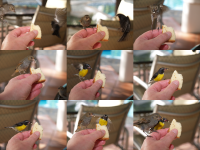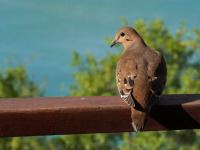biowizard
Member

One thing that always amazes me, is just how fearless of humans, many Caribbean birds are. In St Lucia, you only have to open a door or a window, and within moments one or more Lesser Antillean Bullfinches will fly in, knowing where to find the kitchen, and totally ignore your presence. These little darlings, together with Grey Tremblers, Zenaida Doves, Bananaquits, Topical Mocking Birds, Kingbirds and of course the ubiquitous Carib Grackles will pester you at your table during outdoor meals, most coming to hand if offered a morsel of food. Only the Grackles tend to be wary, but will still sneak up to your plate and steal food if they think you are looking the other way.
In the UK, with the possible exceptions of Trafalgar Square Feral Pigeons (Rock Doves), and seaside Herring Gulls, most birds are extremely timid. In my childhood, Sparrows would regularly come to hand or land on your afternoon tea table, but no more. An entire flock will flee the garden the moment I open the kitchen door. Conversely, in St Lucia at least, species that were timid 25 years ago, such as the Grey Trembler, now just walk gently across the table, and up to your hand, to nibble on a piece of buttered toast or whatever other offering you make.
Can anyone explain these extreme differences in general bird behaviour between the UK and SLU?
Here are some shots I took of some Bullfinches and Bananaquits sharing a piece of cake in my left hand. No need for a spotting scope here - just my trusty Olympus 4/3 camera in my right hand ...

In the UK, with the possible exceptions of Trafalgar Square Feral Pigeons (Rock Doves), and seaside Herring Gulls, most birds are extremely timid. In my childhood, Sparrows would regularly come to hand or land on your afternoon tea table, but no more. An entire flock will flee the garden the moment I open the kitchen door. Conversely, in St Lucia at least, species that were timid 25 years ago, such as the Grey Trembler, now just walk gently across the table, and up to your hand, to nibble on a piece of buttered toast or whatever other offering you make.
Can anyone explain these extreme differences in general bird behaviour between the UK and SLU?
Here are some shots I took of some Bullfinches and Bananaquits sharing a piece of cake in my left hand. No need for a spotting scope here - just my trusty Olympus 4/3 camera in my right hand ...








